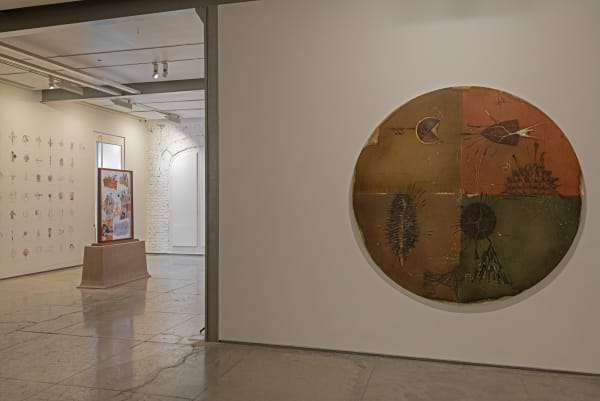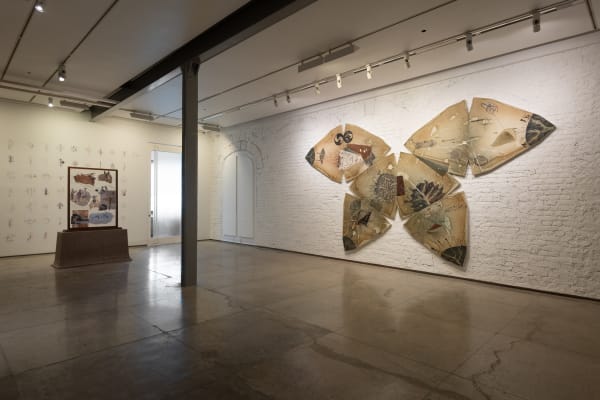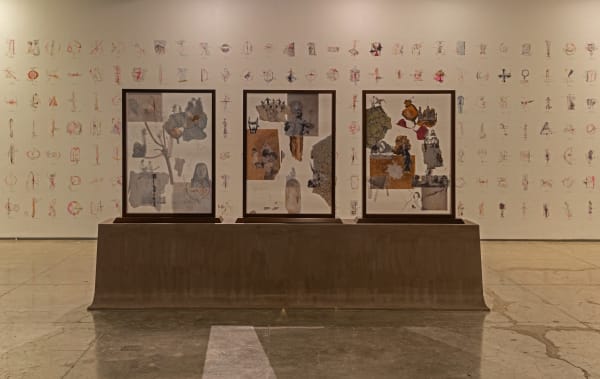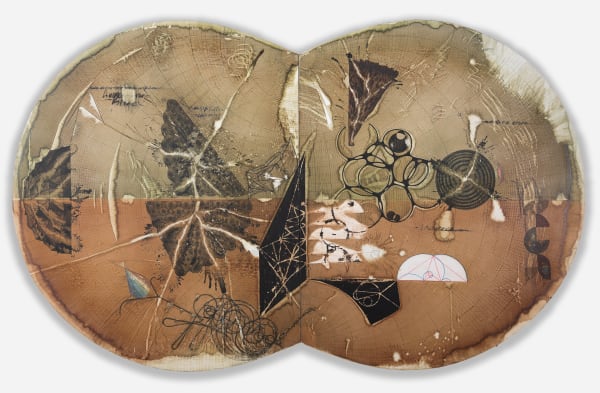Otherwhile: Jitish Kallat
Chemould Prescott Road is proud to present Jitish Kallat’s solo exhibition Otherwhile, twenty-five years since his debut solo at the gallery in 1997. To commemorate this extraordinary moment, the gallery is opening the exhibition on that very date, the 4th of December 2022.
Otherwhile is an assembly of various themes and ideas that have stayed consistent through much of Kallat’s work, some of which trace back to his early days in the nineties. Over the years Kallat has created a vast body of work that situates itself at the intersections of science, philosophy, history, mathematics and natural geometry. This exhibitionbrings together a cross section of his vigorously diverse practice: a monumental wallpaper of drawings, large paintings, freestanding double-sided photographic works and sculpture that materializes distant cosmic phenomenon in three dimensions.
Extending his intimate notebook into an immersive mural-like format, Kallat’s Integer Study (drawing from life) is essentially a wallpapered ledger of forms and numbers. Since the beginning of 2021, Kallat has been exploring the planetary present through a daily count of the world population. One encounters 365 drawings, each displaying the algorithmically estimated births and deaths that have occurred up until a specific time each day. With intricate graphite and aquarelle pencil markings and gesso stains, Kallat’s painterly abstraction contrasts with precise data, forming a triangulation of life by mapping birth, death and time. Echoes of existential questions morph into ecological ones, from reflections on climate and extinction to evolution and decay.
Seen in close proximity are double-sided, multi-scopic photo works titled Epicycles. These layered photo works weave together markers of change documented in his studio premises – a fallen stem, a crack in the wall or an abstraction beneath a chair. Kallat combines these familiar images with photographs drawn from the historic 1955 MoMA exhibition “The Family of Man,” which brought together hundreds of images from photographers around the world in the decade following World War II. Coalescing the immediate studio images with a glimpse of humanity from a distant time and place yields a composite portrait of time and transience. These meticulously produced lenticular images create an illusion of depth and impermanence as images appear or disappear while one moves around each Epicycle. The verso of each work reveals images culled from the Integer Study drawings.
Kallat’s large paintings Echo Verse derive their form from various projections of the Earth. The paintings are organised through a gradual transmutation of imagery evolving from a keen observation of nature and its changing patterns. With a hand-drawn graph intricately segmenting the entire surface, the works begin as an unstable, cross-sectional grid that opens up the globe on a flat plane. In place of planetary geography the paintings assemble signs and speculations, at once evoking botanical, sub-oceanic, celestial, and geological formations. Painterly gestures are initiated through controlled interactions of pigment with air and water, alternating moments of hydration and dehydration, rehearsing ‘longue duree’ geological phenomenon in compressed form and time. The paintings are exploratory abstractions that at once amalgamate the outer and inner worlds, bringing forth forms that suggest signatures of growth and entropy.
The exhibition derives its title from Kallat’s most recent photo-work Otherwhile. Rendered on glass are his notational drawings from the nineties, that fuelled some of his earliest artistic intuitions. These are juxtaposed with found images of ‘forced perspective’ where perception is distorted by adjusting the space and distance between two objects, creating an optical illusion. Otherwhile is at once playful and confessional; a reflection on intuition and inference, on the artistic constraints of trying to seize fundamental truths through the limited tools of form and phenomenon.
Elicitation (Cassiopeia A), seen alongside Otherwhile is produced from NASA’s open-source rendition of a dead star’s remains from a stellar explosion that occurred 11000 light-years away. While the star, the youngest known supernova remnant in our Milky Way Galaxy blew up 11,000 years ago, its light reached Earth in the late 1600s. In its death, Cassiopeia A is said to have ejected about 10,000 Earth masses worth of sulphur, 20,000 Earth masses of silicon, 70,000 times Earth-mass of iron, and oxygen equivalent to about three times the mass of the Sun, releasing into the universe the vital ingredients of life. The sculpture is placed on a stack of Bienfang gridded paper, his chosen surface for the year-long Integer Studies project.
Otherwhile, like the rest of Kallat’s artistic universe, sits between fluid speculation, precise measurement and conceptual conjectures. The exhibition interlaces the immediate and the cosmic, the past and present, probing an invariant interiority alongside the urgencies and ambivalence of our ever-changing world.
-
 Jitish Kallat, Otherwhile, install view
Jitish Kallat, Otherwhile, install view -
 Jitish Kallat, Otherwhile, install view
Jitish Kallat, Otherwhile, install view -
 Jitish Kallat, Otherwhile, install view
Jitish Kallat, Otherwhile, install view -
 Jitish Kallat, Otherwhile, install view
Jitish Kallat, Otherwhile, install view -
 Jitish Kallat, Otherwhile, install view
Jitish Kallat, Otherwhile, install view -
 Jitish Kallat, Otherwhile, install view
Jitish Kallat, Otherwhile, install view -
 Jitish Kallat, Otherwhile, install view
Jitish Kallat, Otherwhile, install view -
 Jitish KallatOtherwhile, 2022Parallax barrier multi-scopic
Jitish KallatOtherwhile, 2022Parallax barrier multi-scopic
prints on glass, LED tubes115 x 15.5 in
292.1 x 39.4 cmEdition of 3 -
 Jitish Kallat, Elicitation (Cassiopeia A), 2021
Jitish Kallat, Elicitation (Cassiopeia A), 2021 -
 Jitish Kallat, Elicitation (Cassiopeia A), 2021
Jitish Kallat, Elicitation (Cassiopeia A), 2021 -
 Jitish Kallat, Epicycles , 2022
Jitish Kallat, Epicycles , 2022 -
 Jitish Kallat, Epicycles , 2022
Jitish Kallat, Epicycles , 2022 -
 Jitish Kallat, Echo Verse, 2022
Jitish Kallat, Echo Verse, 2022 -
 Jitish Kallat, Echo Verse, 2022
Jitish Kallat, Echo Verse, 2022 -
 Jitish Kallat, Echo Verse, 2022
Jitish Kallat, Echo Verse, 2022 -
 Jitish Kallat, Orientation Study (N.E.S.W), 2022
Jitish Kallat, Orientation Study (N.E.S.W), 2022 -
 Jitish Kallat, Orientation Study (N.E.S.W), 2022
Jitish Kallat, Orientation Study (N.E.S.W), 2022


















